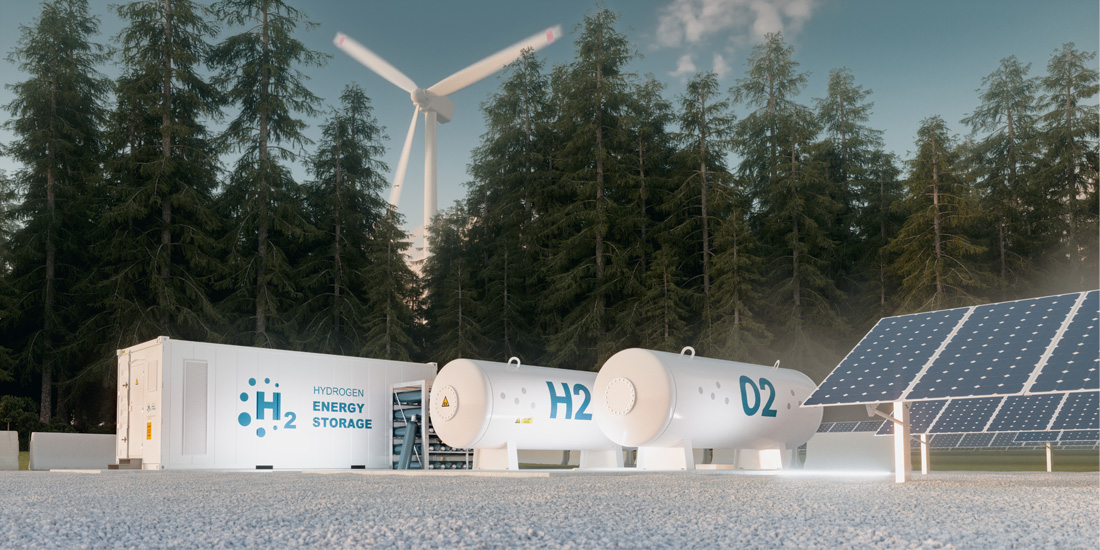Such was the emphasis at COP26 on hydrogen as a sustainable solution to achieving a decarbonised planet, it warranted its own summit: the Hydrogen Transition Summit. In a meeting of minds, experts shared ideas and insights about the challenges of hydrogen as a clean fuel including production, investment and deployment. One of the key outcomes of the summit was the pledge by 28 companies to drive its use and production to increase its contribution to net-zero targets.
With the potential for hydrogen to contribute to avoided emissions of around 800 million tonnes per annum (mtpa) of carbon dioxide (CO2), it’s role in the decarbonisation agenda can’t be underestimated.
We’re going to examine here what makes it such an attractive option in the battle against climate change.
Consisting of only one proton and one electron, hydrogen is both the simplest and the most predominant chemical element in the universe; hydrogen atoms are found everywhere and in huge quantities in humans, plants, animals and water.
As a clean fuel, and leading alternative to methane, it can be produced using a number of different resources such as biomass and renewable power; although in 2020, around 95% of hydrogen was produced from fossil fuels in the order of natural gas, coal, then oil. It also has challenges with compression, transportation and mass production that will need to be resolved to achieve widespread use as a replacement for fossil-fuel derived energy.
For a clear, tasteless and odourless gas, hydrogen has become associated with a spectrum of colours including blue hydrogen, turquoise hydrogen, pink hydrogen, and brown hydrogen with each one relating to the production method used to make it. For example, brown comes from coal and blue from natural gas.
Here, we’re going to be focusing on green hydrogen.
As its name suggests, green hydrogen is produced from techniques that don’t emit greenhouse gases. The most common being the process of electrolysis using renewable energy sources (making it green). By electrolysis we mean the extraction of hydrogen from water using an electrolyser. Water is two parts hydrogen and one part oxygen – which is why it has the formula H₂O – and when an electric current is passed through water, it splits it into the two elements and produces hydrogen and oxygen. This process has no detrimental effect on the environment as the hydrogen can be used as green fuel and the harmless oxygen released into the atmosphere.
Lauded at COP26 as a future key contributor to a carbon-free economy, green hydrogen has the potential to be used in many applications including (in combination with fuel cells) distributed power, storage, auxiliary power for vehicles and cogeneration power. Therefore, it’s also expected to play an important role on a global scale in the decarbonisation of many different sectors, including transportation, aviation and heavy industry.

If we take a closer look at the transport sector, car manufacturers Toyota, Honda and Hyundai already make fuel cell vehicles, and in the UK government’s Hydrogen Strategy, it cites that there are more than 300 hydrogen vehicles in operation on UK roads today. It seem that large-scale production of these vehicles has been slowed, not by production capability, but by the construction of fuelling stations.
And this challenge is undergoing significant mitigation when we review the number of stations currently in operation around the world. Japan is far in the lead with 134 hydrogen fuelling stations, followed by Germany with 90 and the USA which has 46. England has 9 and Scotland 2 – very promising when we consider the size of the country and associated vehicle numbers.
In August this year, the UK government launched its first-ever Hydrogen Strategy, which lays out how a hydrogen economy will contribute to the ‘green industrial revolution’. The strategy carves out how the ambition for 5 gigawatts (GW) of low carbon hydrogen production by 2030 will be achieved and what the investment commitment to reaching this target would be. Finance pledges run into the multi-millions with a provision of £240m for the Net Zero Hydrogen Fund and up to £60m under the Low Carbon Hydrogen Supply 2 competition, which aims to support innovation in the supply of hydrogen.
Hydrogen also played a role in the government’s Heat and Buildings strategy published in October with the announcement of the intention to develop plans for a hydrogen heated town by 2025.
It’s encouraging to see a robust strategy, but the increased production, supply and use of green hydrogen will need a worldwide effort from those COP26 countries for us to reap the rewards.
To receive future blogs about COP26 and net-zero, follow us on LinkedIn.
For help with your net zero strategy and reporting readiness – call us now on 0151 601 3476